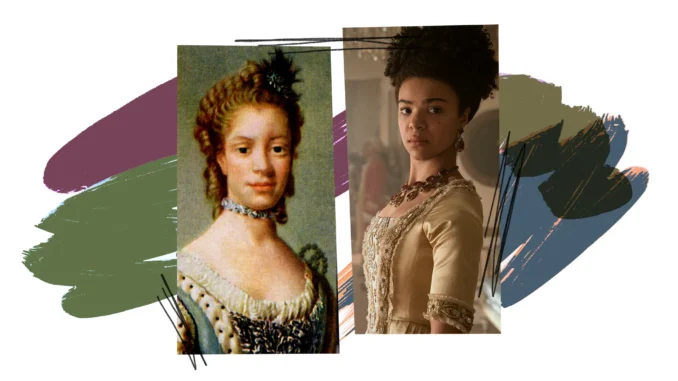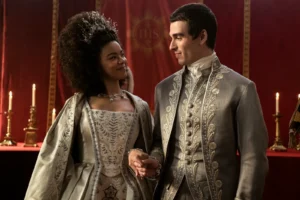
There’s (some) historical truth in Shonda Rhimes’s tale of Britain’s first Black queen, and the “mad” king she fell for.
The Bridgerton-verse has been known to take a creative liberty (or 12) in its depiction of the Regency era. That hasn’t changed with Queen Charlotte: A Bridgerton Story, Netflix’s spin-off series centered on the burgeoning monarch introduced in Shonda Rhimes’s hit romance. But in between a debutante ball set to Beyoncé’s “Halo” and allusions to Meghan Markle, there is a hearty historical basis for Queen Charlotte’s rise.
The six-episode limited series, which is the first installment not based on one of Julia Quinn’s novels, follows a teenage Charlotte (played by Sex Education’s India Amarteifio), who is fated to marry King George (Corey Mylchreest). Their arranged union is part of an “experiment” meant to integrate the races, both through marital union and the promotion of figures like Lady Danbury (Arsema Thomas) to power. Reprising their roles in the prequel series are Bridgerton matriarchs Lady Bridgerton (Ruth Gemmell) and Lady Danbury (Adjoa Andoh), as well as Golda Rosheuvel as the queen herself.
Up until this point, King George and his waning health have only been acknowledged on Bridgerton proper anecdotally or via brief scenes. And although Queen Charlotte’s penchant for Pomeranians and discovery of Mozart have been documented thus far, there is much to learn about both characters as we await the Penelope-and-Colin-centered third season of Bridgerton. Ahead, a look at what’s real behind the reign.
Who Was Queen Charlotte?

Queen Charlotte, born Sophia Charlotte of Mecklenburg-Strelitz, was born on May 19, 1744, in the small northern German enclave presided over by her parents: Duke Charles Louis Frederick of Mecklenburg-Strelitz and Princess Elizabeth Albertina of Saxe-Hildburghausen, as noted in the official royal archives. After ascending the throne in 1761, Charlotte would reign for nearly 60 years, before dying in 1818 of pneumonia.
Did Charlotte and George Get Married That Quickly?
In the Netflix series, a 17-year-old Charlotte travels from Germany to England to marry George III—a match facilitated by both his mother, Princess Augusta (Michelle Fairley), and her brother, Adolphus. That hews closely to the real-life story, according to The Washington Post and the royal archives, which name those two family members as key figures in the arranged marriage between Charlotte and a 22-year-old George. On the show, the day that Charlotte arrives in England also serves as her wedding day, echoing the fact that the actual royal couple was wed just six hours after meeting for the first time.
They would go on to have 15 children, the same figure as shown onscreen. In later episodes of Queen Charlotte, those same heirs express dissatisfaction with their upbringing, arguing that Charlotte views motherhood as nothing more than a monarch’s responsibility. Some historical evidence for that mindset can be seen in this excerpt of Janice Hadlow’s The Strangest Family: The Private Lives of George III, Queen Charlotte and the Hanoverians, via Smithsonian magazine: “I don’t think a prisoner could wish more ardently for his liberty than I wish to be rid of my burden and see the end of my campaign,” Charlotte wrote while carrying her 14th child, Prince Alfred. “I would be happy if I knew this was the last time.”
What Mental Health Issues Labeled King George “Mad”?
For much of the series, viewers are just as obtuse as Queen Charlotte is about what’s keeping King George from fully embracing his new wife, despite their immediate, palpable chemistry. During the time allotted for their honeymoon, George often retreats to his own quarters, not consummating their relationship until confronted by Charlotte about the distance. It’s slowly revealed that George suffers from mental health issues, which manifest via incoherent rants, eccentric drawings, and an inability to separate fantasy from reality. For a time, in an effort to shield her from such outbursts, George insists on seeing Charlotte only every other day.
The real King George suffered similar psychological problems, thus causing the “madness” that would inspire Alan Bennett’s 1991 play, The Madness of George III, and later a 1994 film starring Nigel Hawthorne and Helen Mirren. After George’s true condition becomes known to Charlotte, he insists upon pursuing dangerous “treatments,” including straitjackets, electroshock therapy, and waterboarding, as seen in the series. According to PBS, the real King George underwent similar torture in order to heal, such as ingesting arsenic and being restrained by chains. In the series, upon discovering the nature of George’s attempted remedies, Charlotte insists on letting her husband be and caring for him herself.
